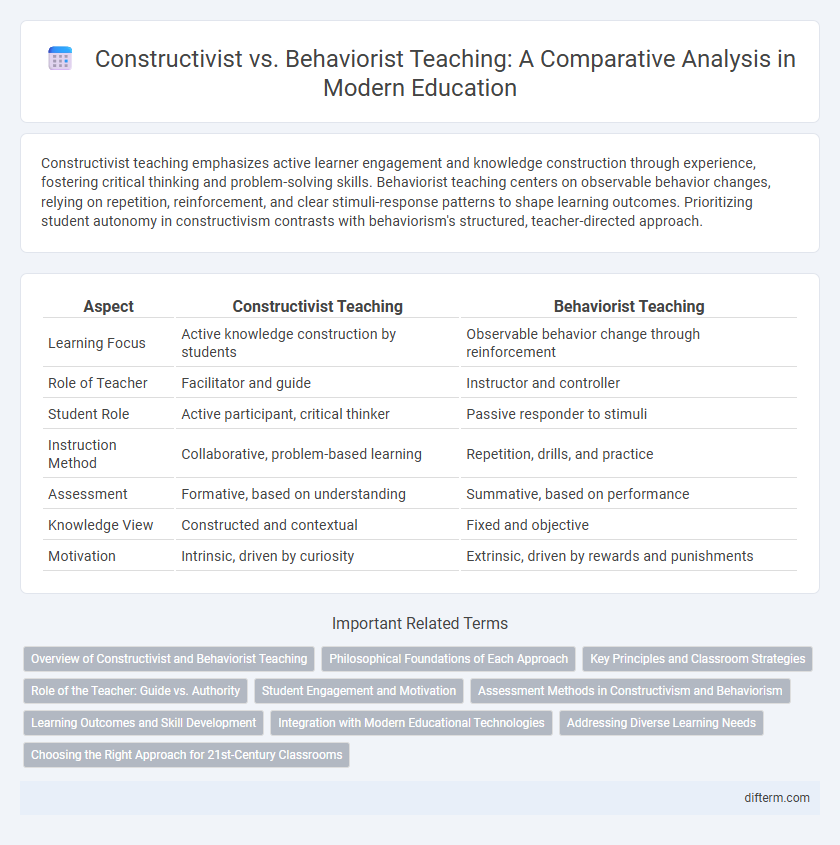Constructivist teaching emphasizes active learner engagement and knowledge construction through experience, fostering critical thinking and problem-solving skills. Behaviorist teaching centers on observable behavior changes, relying on repetition, reinforcement, and clear stimuli-response patterns to shape learning outcomes. Prioritizing student autonomy in constructivism contrasts with behaviorism's structured, teacher-directed approach.
Table of Comparison
| Aspect | Constructivist Teaching | Behaviorist Teaching |
|---|---|---|
| Learning Focus | Active knowledge construction by students | Observable behavior change through reinforcement |
| Role of Teacher | Facilitator and guide | Instructor and controller |
| Student Role | Active participant, critical thinker | Passive responder to stimuli |
| Instruction Method | Collaborative, problem-based learning | Repetition, drills, and practice |
| Assessment | Formative, based on understanding | Summative, based on performance |
| Knowledge View | Constructed and contextual | Fixed and objective |
| Motivation | Intrinsic, driven by curiosity | Extrinsic, driven by rewards and punishments |
Overview of Constructivist and Behaviorist Teaching
Constructivist teaching emphasizes active learning where students build knowledge through experience and reflection, fostering critical thinking and problem-solving skills. Behaviorist teaching focuses on observable behaviors, using reinforcement and repetition to shape student responses and mastery of specific skills. Both approaches influence curriculum design, but constructivism centers on student-centered learning, while behaviorism relies on teacher-directed instruction.
Philosophical Foundations of Each Approach
Constructivist teaching is grounded in epistemological theories emphasizing active knowledge construction through experience and social interaction, drawing heavily on Piaget's and Vygotsky's philosophies that highlight cognitive development and scaffolding. Behaviorist teaching is based on empiricism and stimulus-response principles, as formulated by Skinner and Watson, focusing on observable behavior changes through reinforcement and conditioning. These philosophical foundations define constructivism's learner-centered approach and behaviorism's structured, teacher-directed methods.
Key Principles and Classroom Strategies
Constructivist teaching emphasizes active learner engagement, where students build knowledge through experiences and reflection, using strategies like collaborative projects and inquiry-based learning. Behaviorist teaching focuses on observable behaviors reinforced through repetition and rewards, employing techniques such as drills, rote memorization, and positive reinforcement. Key principles of constructivism include scaffolding and learner autonomy, while behaviorism relies on stimulus-response conditioning and clear, structured feedback.
Role of the Teacher: Guide vs. Authority
In constructivist teaching, the teacher acts as a guide, facilitating student inquiry and encouraging active knowledge construction through exploration and critical thinking. Behaviorist teaching positions the teacher as an authority, directing learning through reinforcement, repetition, and structured practice to shape observable behaviors. This fundamental difference influences classroom dynamics, teaching strategies, and student engagement in the learning process.
Student Engagement and Motivation
Constructivist teaching fosters deep student engagement by encouraging active learning through exploration and collaboration, which enhances intrinsic motivation. Behaviorist teaching relies on external reinforcement and repetition to shape student behavior, often resulting in more compliant but less self-driven learners. Studies show constructivist approaches lead to higher motivation levels and better long-term retention compared to behaviorist methods.
Assessment Methods in Constructivism and Behaviorism
Constructivist teaching emphasizes formative assessment methods such as portfolios, reflective journals, and project-based evaluations that encourage critical thinking and self-assessment. Behaviorist teaching relies heavily on objective assessments like quizzes, tests, and drills designed to measure observable behaviors and reinforce learning through immediate feedback. These contrasting assessment approaches highlight constructivism's focus on deep understanding and behaviorism's emphasis on measurable skill acquisition.
Learning Outcomes and Skill Development
Constructivist teaching promotes active learner engagement and critical thinking, resulting in deeper comprehension and enhanced problem-solving skills. Behaviorist teaching emphasizes repetition and reinforcement, leading to improved memorization and routine task execution. Research indicates constructivist approaches better support higher-order cognitive skills, while behaviorist methods efficiently develop foundational knowledge and specific competencies.
Integration with Modern Educational Technologies
Constructivist teaching leverages modern educational technologies like interactive simulations and virtual reality to foster active learning and critical thinking skills by allowing students to explore and construct knowledge. Behaviorist teaching integrates technology through adaptive learning software and automated assessments, providing immediate feedback and reinforcement to shape desired student behaviors. Both approaches utilize digital tools to enhance learning outcomes but differ in their focus on student agency versus external stimuli.
Addressing Diverse Learning Needs
Constructivist teaching addresses diverse learning needs by encouraging active, personalized learning experiences where students construct knowledge through exploration and collaboration, promoting critical thinking and problem-solving skills. Behaviorist teaching, in contrast, focuses on observable behaviors and reinforcement techniques to shape learning outcomes, often using repetition and rewards to accommodate varying abilities. Both methods can be tailored to support diverse learners, but constructivism emphasizes learner autonomy and adaptability to individual learning styles more explicitly.
Choosing the Right Approach for 21st-Century Classrooms
Constructivist teaching emphasizes active learning, critical thinking, and student-centered inquiry, aligning with 21st-century skills such as collaboration and problem-solving. Behaviorist teaching relies on reinforcement, repetition, and clear learning objectives, ensuring mastery of foundational knowledge and structured environments. Selecting the appropriate approach depends on balancing conceptual understanding with skill acquisition to prepare students for dynamic, technology-driven learning contexts.
Constructivist teaching vs Behaviorist teaching Infographic

 difterm.com
difterm.com